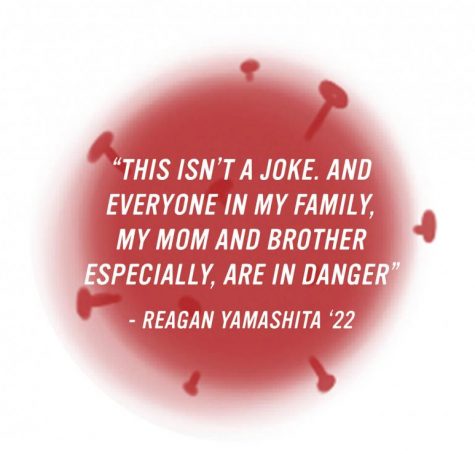Your donation will support the student journalists of West High School. Your contribution will allow us to purchase Scholarship Yearbooks, newsroom equipment and cover our annual website hosting costs.
Clearing the air
April 23, 2020
Because of the mysterious nature of COVID-19, medical professionals have had a hard time finding out more about the virus, and how to combat it. Meanwhile, hysteria and misinformation were spreading.
Referring to COVID-19 as the ‘coronavirus’ can be misleading because there’s more than one type of coronavirus, which is an umbrella term for a category of respiratory diseases. Other branches of the virus, such as SARS (Severe Acute Respiratory Syndrome) and MERS (Middle East Respiratory Syndrome), have been around for much longer. They were discovered in 2002 and 2012 respectively.
Dr. Stanley Perlman, a professor of microbiology and immunology at the University of Iowa, has been studying strains of coronavirus for years. What sets COVID-19 apart is that it’s far more difficult to detect.
“[SARS and MERS are] both really deep lung diseases, so you weren’t contagious until you were pretty sick. This virus is different because it’s much more contagious … and much more lethal,” Perlman said. At first, the media and the public compared COVID-19 to the flu, saying that the flu kills more people each year and there’s no need to worry about it. Even now, many dismiss health warnings because it doesn’t affect them.
Teenagers and children often experience only minor symptoms, such as a cough, runny nose or fever. This leaves older adults and anyone who is immunocompromised, or those who have impaired immune systems, at risk.
Lila Terry ’20 has a family member currently undergoing chemotherapy, which severely limits the body’s ability to fend off infection. COVID-19 directly affects her, and there’s no opportunity to dismiss it with a family member at risk.
“[It’s difficult] hearing somebody say ‘Oh, it’s not going to affect me; it’s just a glorified cold.’ That may be a glorified cold for you, but for the person in my family it may be deadly,” Terry said.
For Terry, it can be offensive to hear the remarks people are making about the virus and the populations it can affect, and she attributes the comments to ignorance.
“They’re acknowledging that there’s a group of people who this is going to affect negatively, but because they’re not in that group of immunocompromised people, they don’t care,” Terry said.
Drew Peterson ’21 is part of that immunocompromised group. He was diagnosed with Type 1 diabetes in September, which is an autoimmune disease that affects insulin production.
Because of this, Peterson and his family have limited their contact with the outside world to ensure the virus does not reach their home.

“I’m doing my best to avoid people and that’s really all I can worry about, so I’m not letting it freak me out too much,” Peterson said. “I still do stuff outdoors and I try to maintain six feet from people when I’m outside.”
It wasn’t until Peterson saw a tweet about somebody’s symptoms that he realized the unique risk the virus could pose due to his condition.
“[They] couldn’t keep food down for nine days,” Peterson said. “That made me a little worried because if I can’t eat then my blood sugar will be low, and I need to keep that up or else I might pass out.”
Since Peterson was only recently diagnosed with diabetes, his family is unaware of how he would react to any common illness, let alone COVID-19.
“I haven’t been seriously sick since I got diabetes so we don’t know what having the flu would do to me,” Peterson said. “Having this unknown pandemic go around the world is even more scary.”
More recent data has shown that COVID-19 isn’t just scary for those who are immunocompromised or high risk. The virus affects a larger percentage of the population than one would have initially believed. According to the WHO, the mortality rate of COVID-19 could be as high as 3-4%.
That’s about the same mortality rate as the flu in 1918, the most severe global pandemic in recent history and one of the flu’s most deadly years. At that time, there was no vaccine for the flu, just like with COVID-19 today. According to Perlman, because of these similarities, COVID-19 and the measures to prevent it shouldn’t be dismissed as unimportant.
“If you have 3% mortality and the disease starts becoming common, that’s a big deal,” Perlman said.
Iowa has seen the impact firsthand. According to the Iowa Department of Public Health, as of April 23, there were 3,748 confirmed cases in the state. These numbers can be frightening to look at, but there are ways to slow the spread of the virus.
This is often referred to as flattening the curve, meaning limiting the number of people who might get infected at any given time. This is important as a large number of cases could overwhelm the healthcare system.
Thorough handwashing, refraining from touching the face and sanitizing frequently-used possessions are all ways individuals can help stop the spread of the virus. However, according to the Centers for Disease Control and Prevention (CDC), social distancing is the one of the most important ways to keep others safe.
On April 3, the CDC recommended that when going outside, people wear face coverings. Hand-made cloth masks are simple to make, and only require an old t-shirt.
It’s important that the public hand-make their own masks, as hoarding of medical-grade masks can leave hospitals out of supplies. This exposes medical staff and makes it dangerous for them to treat patients, and even go home to their families.
Sophomore Reagan Yamashita’s mother works in a nursing home, where the majority of residents are at very high risk of being affected by the virus. At the same time, Yamashita’s brother has a telomere biology disorder which, among other things, makes his lungs weaker.

As a respiratory disease, COVID-19 largely affects the lungs, meaning he’s at an even higher risk of complications. Because of this, Yamashita and her family have to follow a lengthy list of precautions.
“Every time you enter the home you wash your hands and change clothes,” Yamashita said. “My mom has started wearing a mask around the house. We aren’t allowed to touch her or enter her bathroom. If she starts treating infected patients, she will have to live in the basement.”
For Yamashita, it can be frustrating when people dismiss the dangers of the virus and don’t take the necessary precautions.
“It makes me so angry I can’t even begin to tell you,” Yamashita said. “It is estimated that between 100,000-250,000 Americans will die before this pandemic is over. This isn’t a joke. And everyone in my family, my mom and brother especially, is in danger.”
